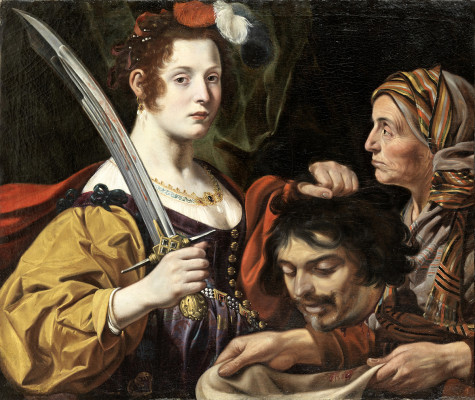Judith with the Head of Holofernes.
Circa 1620-1630.
Oil on canvas, 35 ¼ x 41 5/16 in. (89.5 x 105 cm).
A woman with strong-willed features and determined, thoughtful gaze brandishes a blood-spattered sword in her right hand, and holds a man’s severed head in her left. An old maidservant, wrapped in striped fabric alla giudea, observes the younger woman with amazement as she widens the opening of a sack so as to conceal the object of decapitation. This is the story of Judith, the Jewish heroine who had pretended to be the lover of Holofernes, the Assyrian commander besieging the city of Bethulia; she has just killed the enemy of her people and is preparing to flee the encampment, accompanied by her elderly nurse.
In the canvas before us, this bloody Biblical episode provides an occasion for the representation of the affetti, both refined and harsh. Between the end of the 1500s and the beginning of the century that followed, art in the Christian West saw the spread of an iconography that treated subjects from the Old Testament or Classical mythology as vehicles for portraits and the depiction of sentiment. A general example of this practice can be found in the famous painting by Cristofano Allori (Florence, Palazzo Pitti) in which the woman he loved plays the part of Judith, while the features of the beheaded Holofernes are a self-portrait of the artist. I believe that the approach adopted in our work also corresponds to this use of ancient history, as seems undeniable if we look at Judith’s demonstrative face, her gaze directed at the viewer, and at her refined wardrobe. The scandalous formula of describing a young woman holding a man in her grasp is a rhetorical expedient of Classical origin, and it became elegantly assimilated by Italian painting of the Counter-Reformation.
From the point of view of style, too, this canvas is the mature product of a hybrid cultural phenomenon, an early seventeenth-century union of two distinct pictorial traditions, one from the north of the Alps, the other from Emilia. The harshness of Northern Mannerism is blended with touches of intense and clearly Bolognese-inspired naturalism.
Notwithstanding this particular subject, the composition and lighting do not display any trace of Caravaggesque heritage, but rather a localized focus on verisimilitude, with attention paid to specific elements such as the profile of the old woman or the folds of drapery. Fragments of sharply-observed reality are juxtaposed with more idealised, rhetorical passages, such as the portrait of Judith, or ones that are more dreamed up, as in the case of Holofernes’ head. The underlying flavour in how the heroine’s figure is constructed seems foreign to Italy, while the foreground depiction of the old woman’s hands betray the direct influence of Guercino.
The scene is compact and takes place entirely in the foreground, with no concession to setting but a central drape that falls in triangular folds. The two female figures provide the sole context for the suspended head of the warrior, their dress described in detail according to the two fashions that define the elaborate beauty of one and the modesty of the other. The fabrics themselves have a different consistency, the subtle, starched satin of Judith’s sleeve contrasting with the fustian of the maidservant.
This eclectic language only serves to confirm the dual nature of the painting, and the identity of the artist who was the principal exponent of the hybrid culture we have just mentioned, namely Matteo Loves, the most independent collaborator of Guercino. They may have met as early as 1617/1618, and Matteo was likely in Rome when Guercino was working there for the courtly household of the Ludovisi, between 1621 and 1623. What is certain is that in 1625 Loves was married in Cento to Violante Fabbri, and that they had children who were held at their baptism by the great master (see M. Censi, “Matteo Loves un fiammingo accanto a Guercino”, in Atti e memorie della Deputazione provinciale ferrarese, vol. VIII, 1991). Matteo remained in close touch with Guercino for the rest of his life; he died between 1646 and 1647.
The attitudes and facial features of this Judith with the Head of Holofernes resemble those in the Saint Peter Raising Tabitha in the church of San Pietro in Valle in Fano (see G. Milantoni’s catalogue entry on the painting in La Pinacoteca Civica di Fano, 1993, pp. 262-263). The Marchigian painting includes a cluster of female figures, pale in complexion and wearing robes with broken folds, similar to the work before us, and this repertoire of profiles and gazes is echoed in the present canvas. Its reverse side bears the inscription “Giuditta Oloferne” and two other fragmentary words. In the light of the attribution, established here by means of style, these can clearly be interpreted as the first and last names of our painter: “Mattiha Lorez”, or “Lonez” (the corrupted spelling should be understood as the garbled rewriting of a later period). This painting is a rediscovery that amounts to a truly significant addition for our understanding of the artist’s early period, when he was at his most independent, inventive and imaginative.
The Saint Peter Raising Tabitha cannot be dated precisely, even if it has usually been placed in about 1635 (see A. Emiliani, “Momenti della pittura bolognese del Seicento nella città di Fano”, in Guercino a Fano, ed. by M. R. Valazzi, Fano 2011, p. 25). I believe that this Judith precedes the Tabitha, and that it reflects the artist’s language of the 1620s, in which Northern European elements still prevailed with respect to his gradual assimilation of Guercino’s style, as demonstrated in the subsequent decades. In conclusion, we should point out the clear parallel between the face of the Guardian Angel in the church of Santi Sebastiano e Rocco in Cento and the downturned face of Holofernes, identical in the deliberately elongated aspect of the eyes – almost a mark, or signature, of the artist.
Massimo Pulini
